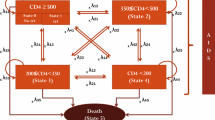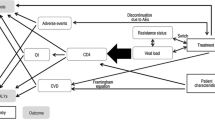Abstract
Objective: To estimate survival, the number of life-years gained and cost effectiveness of antiretroviral therapy (ART) regimens, denoted as ERA-I [zidovudine + (didanosine or zalcitabine)]; ERA-II [stavudine + (didanosine or zalcitabine) or lamivudine + (zidovudine or didanosine or zalcitabine or stavudine)]; and ERA-III [2 nucleoside reverse transcriptase inhibitors + (1 protease inhibitor or 1 non-nucleoside reverse transcriptase inhibitor)].
Design: Modelling of drug cost, cost of opportunistic diseases and survival of HIV-positive men and women in the province of British Columbia who were first prescribed any ART between October 1992 and June 1996. A ‘reference cohort’ was modelled upon individuals in a longitudinal cohort of homosexual men followed since 1982.
Perspective and setting: Third-party payer perspective in BritishColumbia, Canada.
Patients: All HIV-positive men and women aged ≥18 years with CD4+ counts ≤350 cells/μL who were enrolled in the province-wide drug treatment programme. Main outcome measures: Annual costs, survival and cost-effectiveness ratios of successive ART regimens.
Results: Total costs [1997 Canadian dollars ($Can)] at 12 months under ERA-I, -II and -III were $Can4897, $Can6620 and $Can11 914, respectively. Survival at 12 months under ERA-I, -II and -III was 89.6%, 91.0% and 97.6%, respectively. The annual incremental cost (estimated by the total incremental cost at 12months) between ERA-II and ERA-I was $Can1723. The incremental cost-effectiveness ratios between ERA-III and ERA-I, and between ERA-III and ERA-II were $Can58 806 and $Can46 971 per life-year gained, respectively.
Conclusion: We found the cost effectiveness of ERA-III ART regimens well within the range of currently funded therapies for the treatment of other chronic diseases.







Similar content being viewed by others
References
Petrou S. Current controversies in the treatment of HIV infection and AIDS. Pharmacoeconomics 1996; 10 (2): 105–8
Schulman KA, Lynn LA, Glick HA, et a. Cost effectiveness of low-dose zidovudine therapy for asymptomatic patients with human immunodeficiency virus (HIV) infection. Ann Intern Med 1991; 114 (9): 798–802
Chancellor JV, Hill AM, Sabin CA, et al. Modelling the cost effectiveness of lamivudine/zidovudine combination therapy in HIV infection. Pharmacoeconomics 1997 Jul; 12 (1) 54–66
Moore RD, Bartlett JG. Combination antiretroviral therapy in HIV infection. Pharmacoeconomics 1996 Aug; 10 (2): 109–13
Sendi PP, Bucher HC, Harr T, et al. Cost effectiveness of highly active antiretroviral therapy in HIV-infected patients. AIDS 1999; 13: 1115–22
Bloom DE, Carliner G. The economic impact of AIDS in the United States. Science 1988; 239: 604–9
Scitovsky AA, Rice DP. Estimates of the direct and indirect costs of acquired immunodeficiency syndrome in the United States, 1985, 1986, and 1991. Public Health Reports 1987; 102: 5–17
Freedberg KA, Scharfstein JA, Seage III GR, et al. The cost-effectiveness of preventing AIDS-related opportunistic infections. JAMA 1998; 279: 130–6
Hogg RS, Heath KV, Yip B, et al. Improved survival among HIV-infected individuals following initiation of antiretroviral therapy. JAMA 1998; 279: 450–4
Hogg RS, Rhone SA, Yip B, et al. Antiviral effect of double and triple drug combinations amongst HIV-infected adults: lessons from the implementation of viral load driven antiretroviral therapy. AIDS 1998; 12: 279–84
Carpenter CCJ, Fischl MA, Hammer SC, et al. Antiretroviral therapy for HIV infection in 1997: updated recommendations of the international AIDS society - USA panel. JAMA 1997; 277 (24): 1962–9
Hogg RS, Yip B, Kully C, et al. Improved survival among HIV-infected patients after initiation of triple-drug antiretroviral regimens. CMAJ 1999; 160 (5): 659–65
World Health Organization. Acquired immune deficiency syndrome (AIDS): interim proposal for a WHO staging system for HIV infection and disease. Wkly Epidemol Rec 1990; 65 (29): 221–4
Schechter MT, Craib KJP, Le TN, et al. Progression to AIDS and predictors of AIDS in seroprevalent and seroincident cohorts of homosexual men. AIDS 1989; 3: 347–53
Centers for Disease Control. 1993 revised classification system for HIV infection and expanded surveillance case definition for AIDS among adolescents and adults [no RR-17].MMWR Morb Mortal Wkly Rep 1992 Dec; 41: 1–19
Anis AH, Hogg RS, Wang X, et al. Modelling the potential economic impact of viral load-driven triple drug combination antiretroviral therapy. Pharmacoeconomics 1998 Jun; 13 (6): 697–705
Consumer Price Index (Medicinal and Pharmaceutical Products). Statistics Canada; Cat. 62–553, 1997
Canadian Coordinating Office for Health Technology Assessment. Guidelines for economic evaluation of pharmaceuticals: Canada. 2nd ed. Ottawa: Canadian Coordinating Office for Health Technology Assessment (CCOHTA), 1997
Drummond MF, Torrance GW, Mason JM. Cost-effectiveness leagues tables: more harm than good? Soc Sci Med 1993; 37: 33–40
Laupacis A, Feeny D, Detsky AS, et al. How attractive does a new technology have to be to warrant adoption and utilization? Tentative guidelines for using clinical and economic evaluations. Can Med Assoc J 1992; 146: 473–81
Anis AH. Pharmaceutical prices with insurance coverage and formularies. Can J Econ 1992; 25: 420–37
Acknowledgements
This work was supported by the National Health Research Development Programme of the Department of National Health and Welfare of Canada through a National Health Research Scholar Award to Dr Hogg and Dr Montaner, and through a National AIDS Research Scientist Award to Dr Schechter. Dr Anis’s research programme is supported by a grant from the B.C. Ministry of Health and the Ministry responsible for Seniors.
Wethank Diane Campbell, Rita Dewletian, Bonnie Devlin, Elizabeth Ferris, Nada Gataric, Ramona Gomes, Deborah Hamann-Trou, Kelly Hsu, Hector Leon, Tuhin Rahman, Myrna Reginaldo, Diane Skippen and Fatma Telli for their research and administrative assistance.
Author information
Authors and Affiliations
Rights and permissions
About this article
Cite this article
Anis, A.H., Guh, D., Hogg, R.S. et al. The Cost Effectiveness of Antiretroviral Regimens for the Treatment of HIV/AIDS. Pharmacoeconomics 18, 393–404 (2000). https://doi.org/10.2165/00019053-200018040-00007
Published:
Issue Date:
DOI: https://doi.org/10.2165/00019053-200018040-00007




